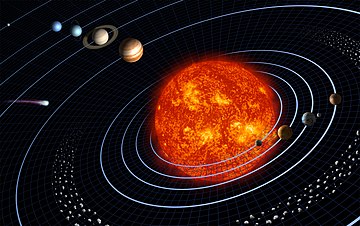目前分類:UNIVERSE宇宙 (2)
- Jul 24 Thu 2008 14:59
 ~UNIVERSE~ Crop Circles 華麗。麥田圈
~UNIVERSE~ Crop Circles 華麗。麥田圈
- Dec 19 Wed 2007 14:11
 ~CURIOUS~ SOLAR SYSTEM OF THE UNIVERSE 宇宙中的太陽系
~CURIOUS~ SOLAR SYSTEM OF THE UNIVERSE 宇宙中的太陽系
 Before Reading
Before Reading
solar system 太陽系
inner planet 內太陽系 outer planet 外太陽系
Mercury 水星 Venus 金星
Earth 地球 Mars 火星
Jupiter 木星 Saturn 土星
Uranus 天王星 Neptune 海王星
矮行星 drawf planets Pluto 冥王星
Kuiper Belt (中譯)科伊伯帶 comet 彗星
Oort cloud (中譯)歐特雲
-----------------------------------------------------------------------------------------------------------
The Solar System or solar system consists of the Sun and the other celestial objects gravitationally bound to it: the eight planets. their 166 known moons. Three dwarf planets (Ceres, Pluto, and Eris and their four known moons), and billions of small bodies. This last category includes asteroids, Kuiper belt objects, comets, meteoroids, and interplanetary dust.
In broad terms, the charted regions of the Solar System consist of the Sun, four terrestrial inner planets, an asteroid belt composed of small rocky bodies, four gas giant outer planets, and a second belt, called the Kuiper belt, composed of icy objects. Beyond the Kuiper belt is the scattered disc, the heliopause, and ultimately the hypothetical Oort cloud.
太陽系是包含了太陽還有其他的天體物質, 所謂天體物質就包含了我們的 "八大行星" 、166個已知的衛星、3個已知的矮行星和他們各自的衛星、還有數不清的星體。
這些數不清的星體中又涵蓋了一些小行星、科伊伯帶的物體、彗星、隕石和星塵。
從圖片上,可以廣泛一些地來說。
也就是太陽系以太陽為中心點往外依序是4個內太陽系的星球(包括了Mercury, Venus, Earth, Mars四個岩陸構造的星球), 四個內太陽系星球之外有一條小行星帶(佈滿了小岩體物質), 行星帶之外便是太陽系的外太陽系的4個巨大星球(分別是Jupiter, Saturn, Uranus, Neptune氣體星球), 外太陽系外圍的第二條就是Kuiper Belt科伊伯帶(佈滿了冰凍物質), 在Kuiper Belt之外便是星辰碎片,還有太陽風層頂(專有名詞1.)和目前為假設性的Oort cloud(歐特雲)。
In order of their distances from the Sun, the planets are Mercury, Venus, Earth, Mars, Jupiter, Saturn, Uranus, and Neptune. Six of the eight planets are in turn orbited by natural satellites, usually termed "moons" after Earth's Moon, and each of the outer planets is encircled by planetary rings of dust and other particles. All the planets except Earth are named after gods and goddesses from Greco-Roman mythology. The three dwarf planets are Pluto, the largest known Kuiper belt object; Ceres, the largest object in the asteroid belt; and Eris, which lies in the scattered disc.
太陽系的八大行星則又內而外依序是水星、金星、地球、火星、木星、土星、天王星、海王星。
除了地球,其他的七個行星都是以古希臘神話中的人物作為命名的。三個已知的矮行星PLUTO,科伊伯帶的最大星體;Ceres, 小行星帶的最大星體;Eris, 則是存在於星塵碎片之中。
呼~這是一篇我自己也找了很多資料的文章。
第一,自己其實對這些宇宙的大朋友們還蠻有興趣的
第二,文章中有一些我自己連中文都不知道的一些名稱和專有名詞,我還是特地去找了相關的資料,認真的研究到底他們是什麼東西。
第三,我竟然線再才知道九大行星已經變成八個了,冥王星被降職了@@
好啦關於第三點我是孤陋寡聞,不過原來太陽系的大略構造就是這樣分布的,看了這樣一篇短短的文章,我的認知就不再只是:"太陽系大概就是八大行星"這樣而已。
希望剛好不知道又剛好看到這一篇文章的你,也可以有所收穫喔!
最後
附上"太陽風"(solar wind) 的簡單解釋
(有關於文章中出現的heliopause)
太陽釋放巨大能量。其中部份能量以帶電荷粒子形式高速傳送開去,這便是太陽風。它的移動速度達到每秒數百公里。雖然地球上的磁場能將環繞地球的帶電荷粒子困於其輻射帶(Van Allen belts),一般能有效阻擋太陽風,但在猛烈太陽風情況下它可能受影響而變形,導致地磁暴的出現。
根據觀測發現,太陽風可分為兩種,一種是從光亮日冕區持續不斷輻射出來的,速度比較慢。在飛到地球附近時,平均速度約為每秒450公里。其粒子含量較少,每立方公分所含的質子數大約1-10個,這種太陽風稱之為『寧靜太陽風』或是『慢速太陽風』。另一種太陽風是從日冕洞所輻射出來,其速度比較快。在飛到地球附近時,平均速度可達每秒1000-2000公里之快。其粒子含量較多,每立方公分所含的質子數約為十幾個,這種太陽風稱為『擾動太陽風』或是『高速太陽風』。那為什麼從光亮日冕區和日冕洞所輻射出的太陽風速度差了如此之大,因為日冕洞是開放的磁力線區,光亮日冕區是封閉的磁力線區,由於開放磁力區的電漿匯流失於廣大的星際空間中,因此電漿密度低、散射的光少故光度黯淡形成日冕洞。日冕洞磁力線管截面積快速向外增加,沿著磁力線運動的電漿獲得加速,就好像高速公路上路面變寬車速就會加快一樣,所以日冕洞所輻射出的太陽風速度才會如此之高。
(以上英文內容基於作者興趣查詢Wikipedia)




